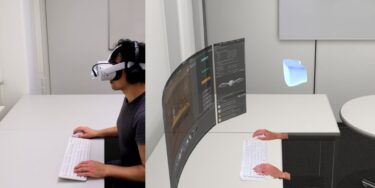Asynchronous reality: researchers stop time in virtual reality

To promote focus, two researchers use a VR headset to blank out interruptions in real life and record them for later viewing. Is this what the work of the future will look like?
Scientists at ETH Zurich introduce the concept of "asynchronous reality" in their research paper. Here, time is paused in an immersive work environment to enable concentrated work. Events missed in reality are recorded and can then be caught up on in virtual reality.
Focus work in VR
Mark Zuckerberg's Meta sees the future of AR and VR headsets predominantly in the work environment. The upcoming high-end VR headset Cambria could show how XR will replace the laptop in the future.
A research team at ETH Zurich is developing an as yet unique tool that shows what new possibilities the XR workplace could bring: "Asynchronous Reality" is intended to promote immersive work in virtual reality. The researchers want to achieve this with a so-called "Focus Mode" that stops the time at the virtual workplace.
Interactions from reality or from colleagues working with you via an AR interface are blocked out. Only when you deactivate the focus mode does time resume normally. Past events are then caught up in your virtual workspace. To create an asynchronous reality, the system reconstructs volumetric scenes with 3D depth cameras in real time. According to the researchers, the system should be able to recognize causal dependencies of actions and selectively replay situations.
Asynchronous reality in everyday work: an example
In a nine-minute video, the researchers show what a working day in asynchronous reality might look like. The example scenario shows a programmer working with his colleague in an immersive work environment on a VR game and the resulting 3D design of an action figure.
Video: via Christian Holz on Twitter
The office is equipped with cameras, and people and objects are streamed into the virtual environment via real-time 3D scans. After meetings in reality and a shared virtual work environment, the programmer switches to focus mode. To block out distractions, the VR headset plays a sound and the system only fades in scanned objects in the immediate vicinity, such as the mouse, keyboard or desk.
Past events are played back as hologram recordings
When a colleague walks through the door, she is scanned by the cameras. However, the programmer does not notice this at first. The system saves the entire process and any changes in the room that occur, for example, when a new object is brought in.
These new objects are initially rendered only as glittering outlines. The programmer therefore does not notice them until he consciously turns his attention to them. He is not automatically notified.
If he sees a new object and wants to examine it, he taps on it in virtual reality. The system plays the recorded event for him like a short hologram. He sees the colleague bring in the object, place it on the table and hears what she says to him.
Asynchronous Reality recognizes causal relationships
When multiple events occur during focus mode that changes previous events, such as adding or removing new objects, the system detects the causal relationships between these actions. It creates a timeline and marks related events automatically.
Thus, if the programmer first plays the event that last occurred after the focus mode ended, the system first shows him the events that are necessary to understand the entire process. For more examples and details on the Asynchronous Reality Office prototype, see the research paper.
Note: Links to online stores in articles can be so-called affiliate links. If you buy through this link, MIXED receives a commission from the provider. For you the price does not change.